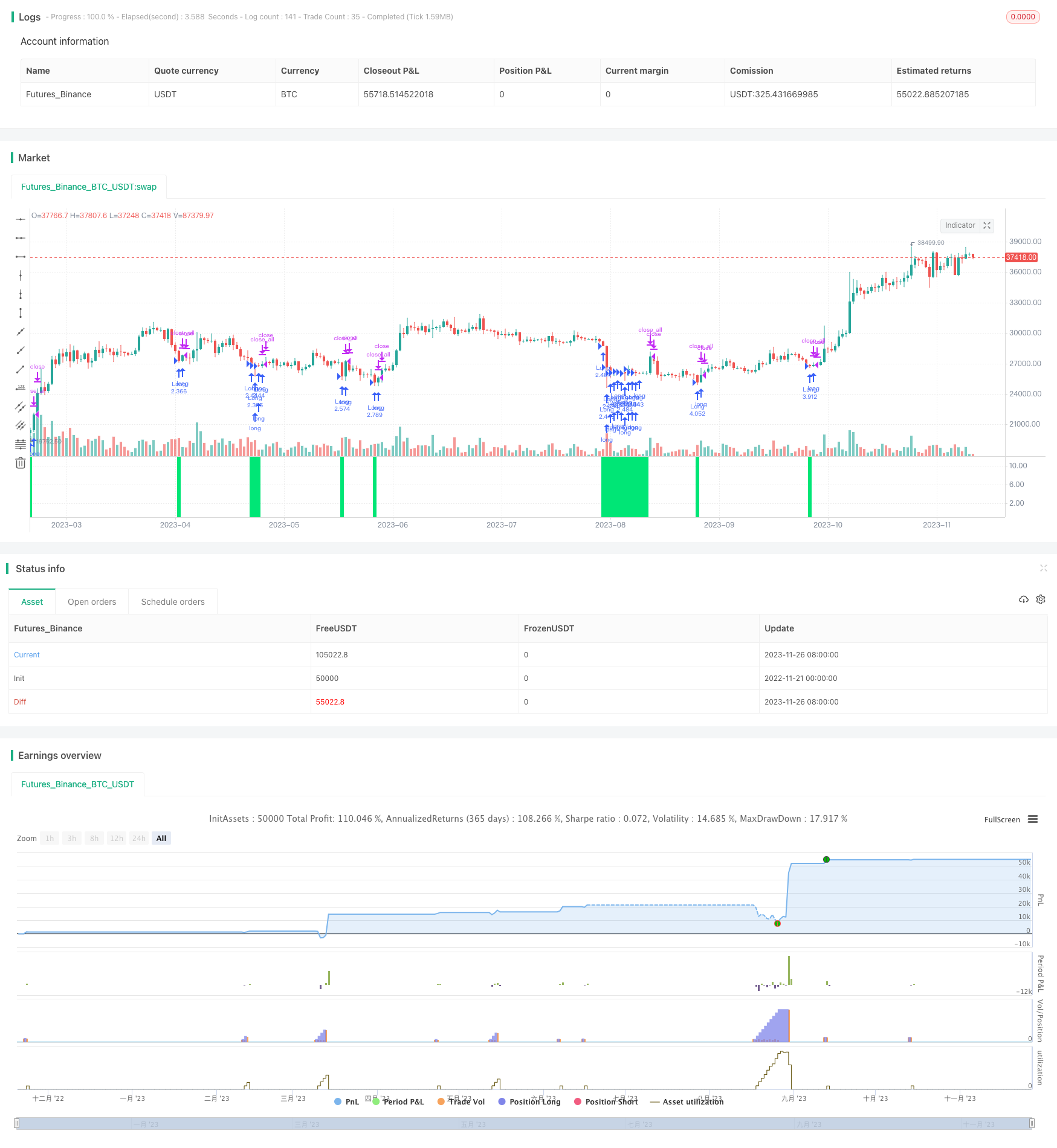
概述
多重RSI指标交易策略通过组合使用多个RSI指标来识别交易机会,实现趋势跟踪。策略灵活运用1-5个RSI指标,根据指标数值判断入场和出场时机。
策略原理
该策略通过输入参数选择使用1-5个RSI指标,每个RSI指标都可以独立配置参数期数和限值。当任意一个RSI指标数值低于对应限值时产生买入信号,信号强度由触发信号的RSI指标期数决定,期数越高信号越强。当RSI指标回升超过限值时产生平仓信号。策略可以灵活使用颜色过滤器,以及设置交易时间段进行限制。
优势分析
该策略最大优势在于可以同时评估多个周期的RSI指标,从长短多个维度判断趋势和反转机会,提高交易决策的准确性。另外,策略允许自由配置各RSI指标的参数,可以针对不同市场调整,可以大大扩展策略的适应性。通过颜色过滤,也可以有效过滤假突破。此外,还加入了交易时间和仓位控制模块,可以有效控制风险。
风险分析
该策略主要风险在于多重RSI指标组合判断时,可能会出现信号冲突的情况。例如短周期RSI产生买入信号,但长周期RSI仍处于超卖状态,这时究竟以哪个信号为准需要结合交易者自己的经验进行决策。此外,RSI指标容易受到震荡行情的误导,这点需要通过辅助指标或大资金的账户进行验证。
优化方向
该策略可以考虑加入移动平均线或布林带等趋势辅助指标来验证RSI信号,提高判断的准确性。此外,也可以思考加入一定的机器学习算法,利用多因子评分的方法来自动判断Entry和Close信号的可靠性。从风险控制角度考虑,也可以设置浮亏线或最大回撤线来止损。
总结
多重RSI指标交易策略整体来说非常有创新性,其指标组合和参数设置的灵活性为快速适应市场变化提供了可能。加入的模块化功能设计也使得策略优化空间很大。如果再配合机器学习或风险控制手段,效果可以进一步提升。
策略源码
/*backtest
start: 2022-11-21 00:00:00
end: 2023-11-27 00:00:00
period: 1d
basePeriod: 1h
exchanges: [{"eid":"Futures_Binance","currency":"BTC_USDT"}]
*/
//Noro
//2018
//@version=2
strategy(title = "Noro's Symphony Strategy v1.1", shorttitle = "Symphony str 1.1", overlay = false, default_qty_type = strategy.percent_of_equity, default_qty_value = 100, pyramiding = 20)
//Settings
//needlong = input(true, defval = true, title = "Long")
//needshort = input(true, defval = true, title = "Short")
capital = input(100, defval = 100, minval = 1, maxval = 10000, title = "Lot, %")
usersi1 = input(true, defval = true, title = "Use RSI 1")
rsiperiod1 = input(4, defval = 4, minval = 2, maxval = 100, title = "RSI 1 Period")
rsilimit1 = input(20, defval = 20, minval = 2, maxval = 50, title = "RSI 1 Limit")
usersi2 = input(true, defval = true, title = "Use RSI 2")
rsiperiod2 = input(7, defval = 7, minval = 2, maxval = 100, title = "RSI 2 Period")
rsilimit2 = input(25, defval = 25, minval = 2, maxval = 50, title = "RSI 2 Limit")
usersi3 = input(true, defval = true, title = "Use RSI 3")
rsiperiod3 = input(14, defval = 14, minval = 2, maxval = 100, title = "RSI 3 Period")
rsilimit3 = input(30, defval = 30, minval = 2, maxval = 50, title = "RSI 3 Limit")
usersi4 = input(false, defval = false, title = "Use RSI 4")
rsiperiod4 = input(21, defval = 21, minval = 2, maxval = 100, title = "RSI 4 Period")
rsilimit4 = input(35, defval = 35, minval = 2, maxval = 50, title = "RSI 4 Limit")
usersi5 = input(false, defval = false, title = "Use RSI 5")
rsiperiod5 = input(28, defval = 28, minval = 2, maxval = 100, title = "RSI 5 Period")
rsilimit5 = input(40, defval = 40, minval = 2, maxval = 50, title = "RSI 5 Limit")
cf = input(false, defval = false, title = "Use color filter")
fromyear = input(1900, defval = 1900, minval = 1900, maxval = 2100, title = "From Year")
toyear = input(2100, defval = 2100, minval = 1900, maxval = 2100, title = "To Year")
frommonth = input(01, defval = 01, minval = 01, maxval = 12, title = "From Month")
tomonth = input(12, defval = 12, minval = 01, maxval = 12, title = "To Month")
fromday = input(01, defval = 01, minval = 01, maxval = 31, title = "From Day")
today = input(31, defval = 31, minval = 01, maxval = 31, title = "To Day")
//RSI
rsi1 = rsi(close, rsiperiod1)
rsi2 = rsi(close, rsiperiod2)
rsi3 = rsi(close, rsiperiod3)
rsi4 = rsi(close, rsiperiod4)
rsi5 = rsi(close, rsiperiod5)
//Signals
up1 = rsi1 < rsilimit1 and usersi1
up2 = rsi2 < rsilimit2 and usersi2
up3 = rsi3 < rsilimit3 and usersi3
up4 = rsi4 < rsilimit4 and usersi4
up5 = rsi5 < rsilimit5 and usersi5
str = up5 ? 5 : up4 ? 4 : up3 ? 3 : up2 ? 2 : up1 ? 1 : str[1]
up = up1 or up2 or up3 or up4 or up5
exit = (rsi1 > rsilimit1 and str == 1) or (rsi2 > rsilimit2 and str == 2) or (rsi3 > rsilimit3 and str == 3) or (rsi4 > rsilimit4 and str == 4) or (rsi5 > rsilimit5 and str == 5)
lot = strategy.position_size == 0 ? strategy.equity / close * capital / 100 : lot[1]
//Background
col = up ? lime : na
bgcolor(col, transp = 0)
//Trading
if up and (close < open or cf == false)
strategy.entry("Long", strategy.long, lot, when=(time > timestamp(fromyear, frommonth, fromday, 00, 00) and time < timestamp(toyear, tomonth, today, 23, 59)))
if time > timestamp(toyear, tomonth, today, 23, 59) or exit
strategy.close_all()